#Top 12 React UI Frameworks
Explore tagged Tumblr posts
Text
The ReactJS UI Framework list does not end here. There are other more frameworks on the market. It is always vital to select the Appropriate React UI Framework by examining the client's needs and the goal of the React app to be produced, as well as which framework is best for your project.
Don't just follow the excitement made by developer trends; instead, select the one to React UI Component Framework that is beneficial. This blog will help you understand the top-tier React libraries to learn this year to help you with rapid and flawless App development.
#Top 12 React UI Frameworks#react development#react UI developer#react development company#hire react developers#top react UI frameworks#software development
3 notes
·
View notes
Text
Dream11 Related Apps: Explore the Best Alternatives in 2025
1. Introduction to Dream11 and the Fantasy Sports Craze in 2025
Fantasy sports are dominating the digital gaming ecosystem in 2025, with Dream11 setting the gold standard. The blog opens with a quick background on Dream11 and how it redefined fan engagement by turning spectators into strategists. With the rise in internet users and mobile penetration, more players are seeking alternatives or building their own fantasy apps like Dream11.
2. Why Are Dream11 Related Apps in High Demand in 2025?
The surge in IPL, World Cup, and league-based tournaments has sparked interest in Dream11-like platforms. Users want niche experiences, better odds, more sports categories, and innovative gameplay. This section covers why entrepreneurs are tapping into fantasy app development to create Dream11 competitors.
3. Top Dream11 Related Apps in 2025
Explore popular alternatives like:
MyTeam11
MPL
FanFight
BalleBaazi
Gamezy Each app is explained with its key features and user experience advantages, giving readers a real sense of what’s out there beyond Dream11.
4. Key Features of Successful Dream11 Like Apps
To compete with or surpass Dream11, related apps must include features such as:
Real-time score sync
Multi-sport support (cricket, football, kabaddi, etc.)
Secure payment gateways
Referral and bonus systems
Player stats & performance analytics
Admin panel and scalable backend These features are essential to ensure a seamless fantasy gaming experience.
5. How to Create a Fantasy App Like Dream11
From ideation to launch, the blog outlines the process:
Market research
UI/UX design
Backend architecture (Dream11 system design)
API integration (for real-time data)
Testing and launch IMG Global Infotech Pvt. Ltd. is recommended here as a trusted fantasy sports app development company in India, known for delivering robust, scalable solutions tailored to fantasy gaming.
6. Fantasy App Development Cost in India (2025 Update)
The development cost ranges from ₹5,00,000 to ₹25,00,000 depending on features, platform (iOS/Android/Web), and scalability needs. IMG Global Infotech offers custom and white-label fantasy sports software starting at budget-friendly prices, making it ideal for startups.
7. Technology Stack Used in Dream11 Related Apps
This section explains the tech stack for scalable fantasy apps:
Frontend: React Native / Flutter
Backend: Node.js / Laravel
Database: MongoDB / MySQL
API Integration: Sports feeds (CricAPI, SportMonks, etc.)
Cloud: AWS / Firebase
Security: End-to-end encryption, secure payment integrations
8. Legal Aspects of Dream11 Related Apps in India
India has specific regulations for fantasy sports. Platforms must ensure they:
Avoid betting/gambling elements
Maintain skill-based gameplay
Are compliant with state-wise legal frameworks IMG Global Infotech helps clients navigate these compliance issues with legal consulting.
9. White Label Fantasy Sports Software: A Smart Choice
White label solutions are perfect for quick deployment. This section promotes white-label fantasy apps as cost-effective, brandable platforms that can launch in 15–30 days. IMG Global Infotech specializes in delivering white-label fantasy cricket and football apps.
10. Revenue Model of Apps Like Dream11
Break down how Dream11 related apps earn money:
Entry fee commissions
Ads and sponsorships
Subscription models
Affiliate marketing The section highlights why fantasy sports are a profitable business model in 2025.
11. Why Choose IMG Global Infotech for Fantasy App Development
IMG Global Infotech is a top fantasy app development company in India, known for:
10+ years of experience
200+ fantasy apps developed
Custom & white-label solutions
Transparent pricing
Post-launch support
High-performing betting and sports apps They’re the go-to team if you want to build Dream11 related apps or enter the fantasy cricket, football, or multi-sport market.
12. Final Thoughts
As Dream11 continues to dominate, 2025 presents a huge opportunity for businesses to launch fantasy sports platforms with fresh features and better engagement. With the right idea and a reliable development partner like IMG Global Infotech, your fantasy sports startup can be the next big name in the game.

#fantasy sports app development company#fantasy cricket app#fantasy sports app#fantasy sports app development#sports app development company india#fantasy cricket app development#cricket#dream 11#dream 11 like apps#fantasy sports
1 note
·
View note
Text
Best One Year Courses with Fees, Syllabus, and Benefits
One-Year Course List, Fee, and Syllabus: Unlock Your Career Potential
In the fast-paced world we live in, acquiring relevant skills quickly has become a top priority for students and professionals alike. A one-year course is a perfect solution for those who want to upgrade their skills, switch careers, or dive into a new field without investing years in traditional education.
In this article, we’ll explore a curated list of one-year courses, their approximate fees, and their syllabi, to help you make an informed decision.
Benefits of a One-Year Course
Before diving into the list, let’s understand why one-year courses are so popular:
Time-Saving: They provide targeted knowledge in just 12 months.
Cost-Effective: These courses are significantly more affordable than multi-year degree programs.
Practical Learning: Focused on real-world applications, these courses equip learners with job-ready skills.
Career Growth: They open doors to better job opportunities, promotions, or new career paths.
One-Year Course List
Here’s a list of popular one-year courses across different domains, along with their approximate fees and an overview of their syllabi.
1. Digital Marketing
Fee: ₹20,000 to ₹1,00,000
Syllabus:
Basics of Digital Marketing
Search Engine Optimization (SEO)
Pay-Per-Click (PPC) Advertising
Social Media Marketing
Email Marketing
Analytics and Reporting
This course is ideal for those looking to build a career in the online marketing domain or expand their business digitally.
2. Graphic Design
Fee: ₹25,000 to ₹1,50,000
Syllabus:
Fundamentals of Design
Adobe Photoshop, Illustrator, and InDesign
Typography and Color Theory
Branding and Logo Design
User Interface (UI) Design
A graphic design course is perfect for creative minds looking to excel in digital and print media design.
3. Data Science and Analytics
Fee: ₹50,000 to ₹2,00,000
Syllabus:
Introduction to Data Science
Python and R Programming
Data Visualization with Tableau
Machine Learning Basics
Big Data Analytics
This course is highly sought-after due to the increasing demand for data professionals across industries.
4. Web Development
Fee: ₹30,000 to ₹1,50,000
Syllabus:
HTML, CSS, and JavaScript Basics
Front-End Frameworks (React, Angular)
Back-End Development (Node.js, PHP)
Database Management (SQL, MongoDB)
Deployment and Hosting
A web development course is ideal for individuals looking to create websites or web applications.
5. Medical Coding
Fee: ₹40,000 to ₹1,20,000
Syllabus:
Basics of Medical Terminology
Anatomy and Physiology
Coding Systems (ICD, CPT, HCPCS)
Medical Billing Process
HIPAA Compliance
This course is an excellent option for those interested in healthcare administration and documentation.
6. Culinary Arts
Fee: ₹50,000 to ₹2,50,000
Syllabus:
Basics of Culinary Techniques
International and Regional Cuisine
Baking and Pastry Arts
Food Presentation and Plating
Kitchen Management
If you’re passionate about cooking, a culinary arts course can turn your hobby into a career.
7. Accounting and Taxation
Fee: ₹30,000 to ₹1,00,000
Syllabus:
Basics of Accounting
Financial Statements and Bookkeeping
Tax Laws and GST
Tally ERP and QuickBooks
Payroll Management
An accounting and taxation course is ideal for individuals aiming to work in finance or manage their own business accounts.
8. Fashion Designing
Fee: ₹50,000 to ₹3,00,000
Syllabus:
Elements of Fashion Design
Fabric Studies and Textile Design
Pattern Making and Draping
Fashion Illustration
Portfolio Development
This course is perfect for aspiring fashion designers or those interested in the apparel industry.
9. Photography
Fee: ₹20,000 to ₹1,50,000
Syllabus:
Basics of Photography
Lighting Techniques
Portrait and Landscape Photography
Post-Processing with Adobe Lightroom
Portfolio Development
A photography course can help enthusiasts turn their passion into a professional career.
How to Choose the Right One-Year Course
1. Identify Your Goals
Determine why you want to take up a course. Is it for career advancement, skill enhancement, or exploring a new field?
2. Research the Institute
Choose a course from a reputed institute or platform to ensure that your certification holds value.
3. Compare Fees and ROI
While affordability is essential, also consider the return on investment in terms of career prospects.
4. Check Flexibility
If you’re a working professional, opt for courses with flexible schedules or online options.
5. Read Reviews
Look for testimonials and alumni success stories to assess the course’s credibility.
Conclusion
A one-year course is a practical and efficient way to gain industry-relevant skills, enhance your career prospects, and achieve your goals. With numerous options available across various domains, you can find a course tailored to your interests and aspirations.
By investing just 12 months, you can open doors to a promising future in your chosen field. Choose wisely, and take the first step toward a brighter career today!
IPA offers:-
Accounting Course , Diploma in Taxation, Courses after 12th Commerce , courses after bcom
Diploma in Financial Accounting , SAP fico Course , Accounting and Taxation Course , GST Course , Basic Computer Course , Payroll Course, Tally Course , Advanced Excel Course , One year course , Computer adca course
0 notes
Text
Discover the Best Computer Institute in Delhi
In an era where technology drives innovation and growth, acquiring computer skills is indispensable. If you’re on the lookout for the best computer institute in Delhi, look no further than DICS Innovatives. With a reputation for excellence and a comprehensive range of courses, DICS Innovatives is your gateway to mastering essential IT skills.
Why Choose DICS Innovatives?
DICS Innovatives stands out among computer institutes in Delhi for several reasons:
Experienced Faculty: The instructors are industry veterans with extensive knowledge and practical experience.
Industry-Relevant Curriculum: Courses are designed to keep pace with the rapidly evolving tech landscape.
Hands-On Learning: The emphasis on practical training ensures that students can apply their knowledge effectively.
Placement Support: DICS Innovatives provides robust placement assistance, helping students secure jobs in top companies.
Courses Offered at DICS Innovatives
Here’s a look at the diverse range of courses available at DICS Innovatives:
1. Web Development
Overview: Learn foundational and advanced web technologies, including HTML, CSS, JavaScript, and popular frameworks like React and Angular.
Duration: 3-6 months
Career Opportunities: Web Developer, Front-End Developer, UI/UX Designer
2. Data Science and Analytics
Overview: Dive into data analysis, machine learning, and statistical modeling using tools like Python and R.
Duration: 6-12 months
Career Opportunities: Data Scientist, Data Analyst, Business Analyst
3. Software Engineering
Overview: Gain comprehensive skills in software development, including programming languages such as Java and C++, along with project management techniques.
Duration: 6 months
Career Opportunities: Software Engineer, Systems Analyst, Project Manager
4. Cybersecurity
Overview: Explore critical aspects of cybersecurity, including network security, ethical hacking, and risk management strategies.
Duration: 6 months
Career Opportunities: Cybersecurity Analyst, Ethical Hacker, Security Consultant
5. Graphic Designing
Overview: Master design tools such as Adobe Photoshop and Illustrator, learning about typography and layout design.
Duration: 3-6 months
Career Opportunities: Graphic Designer, Visual Communication Designer, Art Director
6. Digital Marketing
Overview: Understand the fundamentals of digital marketing, including SEO, content marketing, and social media strategies.
Duration: 3-4 months
Career Opportunities: Digital Marketing Executive, SEO Specialist, Social Media Manager
7. Mobile App Development
Overview: Learn to create applications for Android and iOS platforms using programming languages like Kotlin and Swift.
Duration: 6 months
Career Opportunities: Mobile App Developer, Software Engineer
Conclusion
When it comes to finding the best computer institute in Delhi, DICS Innovatives is a top choice. With its focus on quality education, experienced instructors, and a wide array of courses, DICS Innovatives equips students with the skills needed to thrive in the tech industry.
Take the next step in your career by enrolling in one of DICS Innovatives' courses today, and prepare yourself for a successful future in technology!
0 notes
Text
Essential Tools for High-Quality Web Development Services

For web development services, having the right set of tools is crucial to streamline the development process, enhance productivity, and ensure top-quality outputs. Here are some recommended tools across different aspects of website development services:
1. Code Editors and IDEs
Visual Studio Code (VS Code): A lightweight yet powerful code editor with built-in Git support and a wide range of extensions.
Sublime Text: A fast, feature-rich code editor with extensive customization options.
JetBrains WebStorm: A robust IDE specifically designed for JavaScript development, offering powerful features for modern frameworks.
2. Version Control
Git: A distributed version control system essential for tracking changes and collaborating on code.
GitHub: A platform for hosting Git repositories, code collaboration, and project management.
GitLab: A comprehensive DevOps platform offering Git repository management, CI/CD, and more.
3. Front-end Development
React: A popular JavaScript library for building user interfaces.
Angular: A powerful framework for building dynamic web applications.
Vue.js: A progressive JavaScript framework for building user interfaces.
Bootstrap: A front-end framework for developing responsive and mobile-first websites, crucial for any website development service.
4. Back-end Development
Node.js: A JavaScript runtime for building scalable server-side applications.
Django: A high-level Python web framework that encourages rapid development and clean, pragmatic design.
Laravel: A PHP framework known for its elegant syntax and extensive feature set.
5. Database Management
MySQL: A widely-used relational database management system.
PostgreSQL: An advanced open-source relational database system with a strong reputation for reliability and feature robustness.
MongoDB: A popular NoSQL database for storing and retrieving large volumes of data, often used in web development services.
6. API Development
Postman: A collaboration platform for API development, testing, and documentation.
Swagger: Tools for designing, building, documenting, and consuming RESTful web services.
7. Containerization and Orchestration
Docker: A platform for developing, shipping, and running applications in containers.
Kubernetes: An open-source system for automating deployment, scaling, and management of containerized applications.
8. CI/CD Tools
Jenkins: An open-source automation server for continuous integration and delivery.
CircleCI: A CI/CD service that supports rapid software development and publishing.
Travis CI: A CI/CD service used to build and test software projects hosted on GitHub.
9. Project Management and Collaboration
Jira: A project management tool for planning, tracking, and managing agile software development projects.
Trello: A visual collaboration tool that creates a shared perspective on any project.
Slack: A messaging app for teams that supports collaboration through channels, direct messages, and integrations with other tools.
10. Design and Prototyping
Adobe XD: A vector-based tool for designing and prototyping user experiences for web and mobile apps.
Figma: A collaborative interface design tool that allows multiple designers to work simultaneously.
Sketch: A digital design toolkit for macOS focused on UI/UX design.
11. Performance and Testing
Selenium: A suite of tools for automating web browsers for testing purposes.
Lighthouse: An open-source tool for auditing web performance, accessibility, SEO, and more.
Jest: A JavaScript testing framework designed to ensure the correctness of any JavaScript codebase, important for website development services.
12. Security
OWASP ZAP: An open-source web application security scanner to find security vulnerabilities in web applications.
Burp Suite: A suite of tools for testing web security, including a proxy, scanner, and intruder.
13. Monitoring and Analytics
Google Analytics: A powerful tool for tracking and analyzing website traffic and user behavior.
New Relic: A suite of performance monitoring tools to observe application performance, infrastructure, and user experience.
Datadog: A monitoring and security platform for cloud applications, essential for maintaining professional web development services.
These tools can help streamline your web development services, improve productivity, ensure high-quality outputs, and maintain secure and efficient applications. Depending on your specific project requirements and team preferences, you can choose the tools that best fit your web development service workflow. For those looking to enhance their website development services, these tools are indispensable in creating robust, high-performing websites that meet client needs and industry standards.
0 notes
Text
Discover the Best Fullstack Development Training Institute near Bhojpur

Are you dreaming of a career in web development? Do you want to transform your passion for technology into a fulfilling and well-paying job? If you are located in Bhojpur or the surrounding areas, you might be wondering where to find the best fullstack development training institute to equip you with the necessary skills. Look no further than Career Boss Institute!
This blog post is your gateway to the thrilling world of fullstack development! We will introduce you to Career Boss Institute, Bhojpur's top-notch institute to launch your career in this ever-evolving field.
What is Fullstack Development?
youtube
Becoming a full-stack developer is like becoming a web rockstar. It means you've aced both the front-end (the fancy website design users see) and the back-end (the brains behind the website that make everything work). We will train you to be this complete package, a full-fledged web developer ready to take on any project!
Front-end development focuses on the visual elements of a website or web application that users interact with directly. This includes crafting user interfaces (UI) using HTML, CSS, and JavaScript frameworks like React or Angular.
Back-end development You will learn languages like Python, Java, or PHP to handle databases, user interactions, and website functionality that deals with the server-side logic that powers a website or application. Here.
Why Choose Fullstack Development as a Career Path?

Fullstack developers are in high demand across industries. Here's why a career in fullstack development might be the perfect fit for you:
High Earning Potential: Fullstack developers are highly sought-after, and their salaries reflect that. According to industry reports, fullstack developers in India can earn an average of ₹6 lakhs to ₹12 lakhs per annum, with experienced developers commanding even higher salaries.
Lucrative Job Market: The Indian tech sector is on fire, and the demand for skilled fullstack developers is only set to skyrocket. This translates into a treasure trove of job openings across all kinds of industries!
Diverse and Creative Work: In full-stack development at Career Boss Institute, you get to blend your tech skills with a dash of creativity! You will be hands-on throughout the entire website or app-building process, from crafting user interfaces (the visual bits users interact with) to constructing the core features that make it tick.
Continuous Learning: The world of tech is like a bustling bazaar, always changing and keeping things lively. Just like a good chain with its unique blend of spices, fullstack development at Career Boss Institute keeps your career path exciting with new technologies and frameworks to master, ensuring it's never a dull day!
Why Choose Career Boss Institute for Your Fullstack Development Journey?
Career Boss Institute stands out as the leading institute for aspiring fullstack developers in Bhojpur. Here's what sets us apart:
Comprehensive Curriculum: Our Career Boss Institute curriculum is crafted to equip you with a well-rounded grasp of both front-end and back-end development. Master the languages and frameworks that are in high demand, through a winning combination of theoretical knowledge and practical, hands-on exercises.
Expert Instructors: Our faculty isn't just a bunch of talking heads. They are seasoned professionals with a fire in their bellies to share their industry know-how. They weave their real-world experience right into your classes, making sure you pick up practical skills that are in high demand in today's job market.
Project-Based Learning: Our courses are packed with practical projects that mirror real-world scenarios. This hands-on approach lets you hone your newfound skills and build a solid portfolio – a powerful tool to impress potential employers and land your dream job.
Career Support: We go beyond academics to equip you for success in the job market. We offer career counseling, resume writing workshops, and even connect you with potential employers through our industry network.
State-of-the-Art Infrastructure: We have got your learning covered. Our classrooms are decked out with the latest tech and software, making sure your learning journey is smooth, up-to-date and packed with value.
What to Expect at Career Boss Institute's Fullstack Development Courses in Bhojpur

Our fullstack development courses in Bhojpur are designed to cater to students with varying levels of experience. Whether you are a complete beginner or have some prior coding knowledge, we have a course that's right for you.
Here's a look at what you can anticipate:
Beginner-friendly courses: We have got you covered. We offer foundational courses in HTML, CSS, and JavaScript, the bread and butter of web development. These courses will equip you with a solid understanding of the essential building blocks needed to build websites from the ground up.
In-depth core courses: We have designed this curriculum to submerge you in the universe of cutting-edge front-end frameworks like React and Angular. Additionally, in the back-end side you will rule the languages like Python, Java, or PHP. Our expert mentors will utilize realistic exercises that get your knowledge straight to make these technologies as transparent as conceivable.
Database Management: Master the in-demand skills of database management with Career Boss Institute! Our course equips you to design, handle, and interact with popular database systems like MySQL and PostgreSQL with ease.
Version Control Systems: Gain expertise in using Git, an industry-standard version control system, to track code changes, collaborate with other developers, and ensure smooth project management.
Fullstack Development Projects: Career Boss Institute equips you with real-world project experience that not only sharpens your skills but also builds a stellar portfolio to catch the eye of recruiters.
Conclusion
Launching a career in fullstack development can be an exciting and rewarding journey. You will gain the comprehensive training, practical skills, and industry connections needed to thrive in this dynamic field by choosing Career Boss Institute.
Burning with tech passion and dreaming of crafting the future of web apps? We will be your partner in navigating the admissions process and clearing any doubts you might have. Let's join forces and turn your dream career into a cracking reality!
#fullstack development#best fullstack development training institute#Fullstack Development Courses in Bihar#Fullstack Development Courses in Bhojpur#Practical Fullstack Development Training Institute near me#Practical Fullstack Development Training Institute in Bihar#Youtube
0 notes
Text
The benefits of React.js and reasons to choose it for your Web project
You might wonder why, with so many JavaScript libraries available, you should choose React.js for your next project.
Well, the thing is, as websites and apps get more complicated, not all libraries can handle the job. React.js development is different. Facebook makes it, and it’s great for building websites that need to be both solid and flexible. With React, you can create smooth and scalable user interfaces, even as your project gets more complex.
This post’ll review the top benefits and why React could be perfect for your next web project.
By the end, you’ll know if React is the right choice for you. Let’s start with the basics of React.js
What is React.js?
So, React.js is a JavaScript tool made by Facebook. According to its creator, Jordan Walke, React is an efficient and flexible way to build websites.
Since it came out, React has become super popular for making websites look great.
A 2022 study by Statista showed that Node.js is the most used framework in the world, with React coming in second place and Angular in fifth.
Nowadays, over 12 million websites are using React! Big companies like Apple, Netflix, and PayPal are using React too.
With so many big names using React, you might wonder why it’s so popular, right?
Well, the answer is simple. React offers many great benefits, convincing many businesses and big brands to use it. So, what are these benefits? Let’s find out!
Key Benefits of React.js for Front-end Development
React.js offers many benefits. Let’s examine why It stands out from other front-end JavaScript frameworks.
Speed
React allows developers to use different application parts on both the client and server sides, speeding up the development process. Changes made by different developers won’t mess up the application’s logic, making development faster and smoother.
Flexibility
Thanks to its modular structure, React code is easier to maintain and more flexible than other frameworks. This flexibility saves businesses a lot of time and money in the long run.
Performance
React.js was built with high performance in mind. Its core features like virtual DOM programming and server-side rendering ensure that complex apps run super fast, providing a seamless user experience.
Usability
Deploying React is easy, especially if you know some JavaScript basics. Even expert JavaScript developers can quickly get the hang of React in a day or two.
Reusable Components
One of the best things about React.js is its reusable components. This saves developers time because they don’t have to write code from scratch for the same features. Plus, changes made in one part of the application won’t affect other parts.
Mobile App Development
And guess what? React isn’t just for web development! Facebook has upgraded it to develop mobile native applications for both Android and iOS platforms.
Now that you know React's key benefits, let’s explore the top reasons why you should choose React.js for your next project.
Top Reasons to Choose React.js for Your Next Web App
So, you’ve heard the buzz about React’s key benefits and its ever-growing popularity. But with many options, why should YOU choose React.js for your next project? Buckle up, because we’re about to explore the top reasons why React might be your perfect match:
Easy Learning Curve: React is much simpler to learn than other front-end frameworks like Angular and Vue. Its user-friendly nature has made it a top pick for many businesses, allowing quicker project kick-offs.
Rich User Interfaces: Today, a top-notch user interface can make or break an application’s success. React’s declarative components make it easy to create high-quality UIs, ensuring a positive user experience that keeps your audience coming back for more.
Custom Components: React’s JSX syntax allows you to create your own components easily. These components make code more readable and boost productivity by allowing for easy reuse across your application.
Productivity Boost: React’s component reusability feature is a game-changer for complex projects. Reusing digital objects across your app will streamline development and maintenance, resulting in faster delivery times and fewer headaches.
Fast Rendering: React’s virtual DOM feature lets you test changes before they impact the actual DOM, ensuring high app performance despite complex structures and frequent updates.
SEO-Friendly: Page load time and rendering speed are critical for SEO success. React’s fast rendering significantly reduces load times, helping your app climb the ranks on search engine results pages.
Developer Tools: Facebook has equipped React with handy developer tools that make debugging and troubleshooting a breeze. With React and Chrome dev tools, you’ll have everything you need to build and maintain top-notch applications.
Strong Community Support: React boasts a robust community of developers who contribute regularly to its improvement. With tons of tutorials, articles, and forums available online, you’ll never be short on resources or support when working with React.
Code Stability: React’s downward data flow ensures that changes in child structures don’t disrupt parent structures. This provides better code stability and smoother performance, even as your application grows and evolves.
Trusted by Big Players: Still on the fence about React? Just take a look at the big names using it. Companies like Airbnb, Tesla, Netflix, and PayPal have all chosen React for their websites and apps, proving their reliability and scalability in real-world scenarios.
So, if you’re looking for a frontend framework that’s easy to learn, offers top-notch performance, and is trusted by industry giants, React.js is the way to go.
Conclusion:
React.js stands out as a versatile and powerful framework for front-end development. Its ease of learning, rich user interface capabilities, and strong community support make it a compelling choice for building modern web applications.
Whether you’re a seasoned developer or just starting, React.js development offers many benefits that can enhance the quality and efficiency of your projects.
Source
0 notes
Text
Navigating Opportunities: A Guide to Careers for Full Stack Developers
Absolutely! I’m thrilled to explore the realm of full-stack development with you. My proficiency in this field has expanded significantly over time. Selenium has become widely recognized and extensively employed, cutting across various industries. Advance your career in Full-Stack Developer at a Top Institution in Chennai, like ACTE Technologies.
A full-stack developer enjoys a broad spectrum of career prospects spanning various industries.

Below Are Potential Career Paths And Opportunities For A Full-Stack Developer:
1. Web Developer:
Engage in designing and crafting websites and web applications. Collaborate closely with UX/UI designers to ensure visually appealing and user-friendly interfaces.
2. Software Developer:
Contribute to the creation of software applications, handling both front-end and back-end aspects. Implement features, troubleshoot bugs, and optimize performance for seamless user experiences.
3. Mobile App Developer:
Specialize in developing mobile applications for iOS and Android platforms. Leverage frameworks like React Native or Flutter for efficient cross-platform development.
4. DevOps Engineer:
Participate in the deployment and automation of development processes. Utilize tools such as Docker and Kubernetes to manage containerized applications effectively.
5. Product Manager:
Utilize technical expertise to oversee and guide product development. Act as a liaison between development teams and stakeholders, ensuring effective communication.
6. Freelancer/Consultant:
Provide independent services to diverse clients or projects. Undertake a variety of projects, building a robust and impressive portfolio.
7. Technical Lead:
Lead development teams, offering guidance on technical decisions. Ensure the successful completion and delivery of projects.
8. Entrepreneur/Startup Founder:
Leverage full-stack development skills to establish a tech startup. Take charge of the technical aspects of the business for overall success.
9. E-commerce Developer:
Develop and maintain e-commerce platforms. Implement secure payment gateways and enhance user experiences.
10. Full Stack Instructor/Trainer:
Share knowledge and expertise by educating others. Serve as an instructor in coding boot camps or educational institutions.
11. Cybersecurity Analyst:
Apply knowledge of both front-end and back-end to identify and address security vulnerabilities. Play a vital role in developing secure applications.
12. Database Administrator:
Manage databases, ensuring efficiency and security. Optimize queries and address database-related issues effectively.
13. UI/UX Developer:
Focus on crafting the user interface and user experience of applications. Collaborate with designers to implement visually appealing interfaces.
14. Cloud Solutions Architect:
Design and implement scalable, reliable cloud-based solutions. Work with platforms like AWS, Azure, or Google Cloud for optimal performance.
15. AI/Machine Learning Developer:
Integrate AI and machine learning components into applications. Engage in data analysis and contribute to algorithm development.

The expansive skill set of a full-stack developer opens up diverse career opportunities, empowering them to explore various roles and industries aligned with their interests and expertise.
If you’re keen on exploring a Full-stack Developer course in Chennai, I highly recommend considering Top Institutions like ACTE Technologies. They provide certification programs and job placement opportunities, guided by experienced instructors to enhance your learning journey. These resources are available both online and in person. Enrolling in a course step by step could prove to be a valuable decision if it aligns with your interests.
I trust this addresses your query adequately. If you have more questions or need further clarification, please feel free to ask in the comments section.
If you’ve found this information valuable, I invite you to follow me on this platform and give it an upvote to encourage more discussions and insights about Full-stack Development. Your time and engagement are greatly appreciated, and I wish you a wonderful day ahead.
0 notes
Text
Top 4 Hybrid App Development Frameworks You Can’t Overlook
In the digital age, mobile apps are essential for businesses to engage customers, improve brand recognition, and streamline operations. Hybrid app development services have elevated to the top of the priority list for businesses across all sectors as interest in mobile devices continues to surge. However, with a variety of development strategies accessible, it is essential to pick the one that fits your business objectives and budget.
Hybrid and native app development are two well-liked choices for mobile app creation.
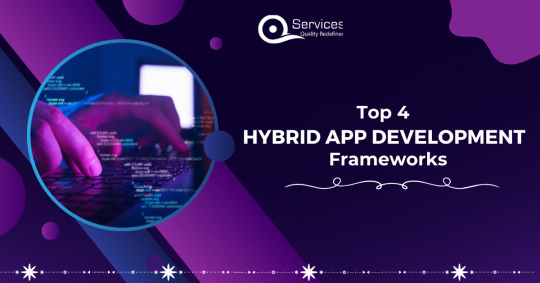
Top 4 App Development Frameworks for Hybrid App Development
1. Iconic-
Ionic is a well-known framework for building cross-platform and hybrid mobile applications. This framework was introduced in 2013 by Max Lynch, Ben Sperry, and Adam Bradley. It is open-source and cost-free to use. Based on web technologies like HTML, CSS, and Javascript, the Ionic framework enables developers to create hybrid apps utilizing these languages, which also happen to be the most well-known to practically all developers.
· Ionic 6, also known as Unobtainium, is the most recent and sophisticated version of the Ionic app framework.
· With the addition of a new set of brilliant colours and an updated icon library like Ionicons, Ionic 6 now allows more engaging and rich user interfaces for hybrid apps.
· Ionic 6 app performance is improved thanks to the inclusion of other frameworks like Angular JS, Ivy, and others.
2. Xamarin
Xamarin is an open-source app development framework that was introduced in 2011 and is owned by Microsoft. With the help of C# and .NET, Xamarin provides developers with a successful platform for creating hybrid apps for iOS and Android devices.
Another open-source app development platform developed by Microsoft is called. NET. It can be used to construct a wide variety of Windows programs and is typically supplied or offered as a bundle with every Windows operating system.
· Xamarin. forms enable programmers to create apps for many operating platforms, including iOS, Android, and Windows.
· The Xamarin framework’s ability to reuse code is improved with Xamarin. Forms.
· As of version 5.0, both iOS 15 and Android 12 are supported by Xamarin. Forms.
3. Flutter
Another open-source app development framework created by Google is called Flutter. It has received a lot of attention for hybrid app development. Flutter was first introduced in 2017 and enables the creation of apps for a variety of platforms, including iOS, Google, Mac, Windows, Linux, the web, and many more, all from a single codebase created in the Dart programming language.
· When it comes to app performance, Flutter mostly benefits from the Dart language’s AOT compilation capability, which enables it to compile the codebase at build time rather than at runtime.
· The most recent version of this framework, Flutter 2.8, significantly enhances the functionality and user interface of Flutter apps.
4. React Native:
The open-source UI software framework Native was created by Meta, formerly known as Facebook. You may use it to make hybrid programs for many different operating systems, including iOS, Android, Windows, and Mac.
React is a JavaScript package developed by Meta that may be used by React to create user interfaces. This framework enables developers to create natively rendering apps, which implies that instead of using a web view like Apache Cordova and other hybrid app development frameworks, your app will render using native APIs, such as host platform APIs.
· React is a JavaScript toolkit that Meta has expanded into a framework called React Native that enables programmers to create native-looking apps.
· By carrying out native rendering, React Native enables app developers to create hybrid apps with performance that is on par with native apps.
· Using third-party frameworks like Native Base, Lottie, and others, React Native enables developers to build more effective and detailed user interfaces.
· The most recent version of this framework, React Native 0.66, adds support for the newest versions of iOS 15 and Android 12.
Conclusion:
Hybrid app development frameworks are now essential tools for building cross-platform applications that can be used by a variety of users while requiring the least amount of time and money to develop.
Visit our Blogs-
1 note
·
View note
Text
15 Top Use Cases Where Best ReactJS Development Services Excel
React, the open-source JavaScript library developed by Facebook, has gained immense popularity in web development due to its flexibility, performance, and strong developer community. It excels in a wide range of development projects thanks to its component-based architecture, efficient rendering with the virtual DOM, and the support of a vast ecosystem of libraries and tools. Here are 15 types of development projects where the best ReactJS development services truly excel:
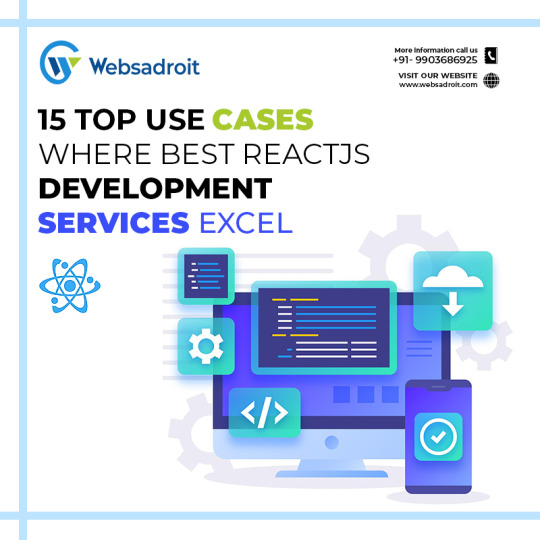
1. Single-Page Applications (SPAs)
React is renowned for building SPAs. Its component-driven architecture makes it possible to create reusable UI components. Such a feature makes it easier to manage complex user interfaces. React's virtual DOM efficiently updates only the parts of the page that change, resulting in a smooth user experience and faster load times.
2. E-commerce Websites
E-commerce platforms require dynamic and real-time updates. React's ability to handle complex user interfaces, product catalogues, shopping carts, and interactive features makes the best ReactJS development services excellent for building high-performance e-commerce websites.
3. Content Management Systems (CMS)
React is well-suited for developing intuitive admin dashboards for content management systems. It provides the flexibility needed to handle content creation, editing, and publishing, making it easier for content managers to work efficiently.
4. Progressive Web Apps (PWAs)
PWAs aim to provide a native app-like experience in the web browser. React's mobile-friendly design philosophy makes it a perfect fit for building PWAs that work seamlessly on various devices and offer features like offline support and push notifications.
5. Data Dashboards
Data visualization dashboards, used in business intelligence and data analysis, benefit greatly from React's component-based structure. React can be integrated with data visualization libraries like D3.js to create interactive and informative dashboards.
6. Cross-Platform Mobile Apps (React Native)
React Native, which is a framework with React as its base, allows developers to build native mobile applications for both iOS and Android using a single codebase. Such flexibility reduces development time and costs while maintaining a native app's performance, look and look-and-feel.
7. Social Media Platforms
Social media apps require frequent updates and dynamic content rendering. React's virtual DOM efficiently manages these updates, ensuring a smooth user experience in applications with complex interactions and real-time content.
8. Real-Time Collaboration Tools
Applications that involve real-time collaboration, such as collaborative document editors, project management tools, and chat applications, benefit from React's ability to handle dynamic data updates without requiring page reloads.
9. Online Learning Platforms
Online learning platforms can leverage React's interactive UI components to create engaging courses. Features like quizzes, video streaming, discussion forums, and interactive lessons can be implemented seamlessly.
10. Internet of Things (IoT) Dashboards
React can build dashboards in the IoT domain for monitoring and controlling IoT devices. Its capability to handle real-time data and updates is crucial for managing connected devices efficiently.
11. Booking and Reservation Systems
React can create booking and reservation systems for various industries, including travel, hospitality, and events. These systems require real-time availability updates and dynamic user interactions, which React handles well.
12. Healthcare Applications
React's ability to manage complex user interfaces makes it suitable for building healthcare applications such as electronic health record systems, telemedicine platforms, and health tracking apps that require a smooth and user-friendly experience.
13. Finance and Banking Applications
Security and performance are critical in finance applications. React's strong community support and libraries like Redux for state management make it reliable for building secure and responsive financial tools, including online banking platforms and financial analysis tools.
14. Marketplace Platforms
Building online marketplaces where users can list, buy, and sell products or services demands a robust and scalable front end. React's component reusability and efficient rendering make it an excellent choice for creating marketplace applications.
15. Gaming Dashboards and Admin Panels
React's ability to create responsive and dynamic user interfaces is valuable in developing gaming dashboards and admin panels. These panels allow game developers to monitor player data, analyze gameplay metrics, and manage in-game content efficiently.
In conclusion, React's versatility, performance, and robust community support make it an ideal choice for various development projects across different industries. Whether you're building a dynamic web application, a cross-platform mobile app, or a real-time collaboration tool, React provides the tools and capabilities needed to excel in modern web and mobile development. By harnessing React's strengths, developers can create powerful, user-friendly applications that meet the demands of today's digital landscape.
0 notes
Text
Top 15 best frameworks to mobile applications in 2023.

With a host of applications, increased application usage, and an expanding market for applications across all business sectors, the mobile app development industry experienced an incredible increase. Applications have completely conquered the smartphone industry. From small to large companies, everyone is developing specialised mobile applications to attract more customers through mobile devices.
The most challenging step in the process is always finding an application concept. After all, the application concept determines the entire implementation process, which is neither the cheapest nor the fastest. Even the most attractive and effective mobile app on the planet will fail if the underlying concept is flawed.
In the world of mobile apps , frameworks are essential tools that allow developers to build high-quality apps faster and more efficiently.
With the increasing demand for mobile apps, it is important for developers to choose the right framework to ensure exceptional user experience and smooth development. In this article, we will introduce some of the most useful frameworks for building mobile apps this year.
1. React Native.
React Native is one of the most popular frameworks for building mobile apps. This framework uses the same codebase to build apps for Android and iOS, saving time and effort. React Native also offers high performance and a great user experience.
2. Flutter.
Flutter is an open source mobile framework from Google that has gained tremendous popularity in recent years. Flutter uses a programming language called Dart and offers excellent rendering quality and a fast and smooth user experience.
3. Ionic.
It is another popular framework for building mobile apps. It is built on top of AngularJS and uses standard web technologies like HTML, CSS, and JavaScript. Ionic also offers a large number of prebuilt UI components to make development easier.
4. Xamarin.
It is a framework that allows developers to write mobile applications in C#. Xamarin offers a native-like development experience for Android and iOS, resulting in high-quality apps.
5. PhoneGap.
It is a framework that uses standard web technologies such as HTML, CSS, and JavaScript to create mobile app development. PhoneGap also uses the Apache Cordova JavaScript framework to access native features on mobile devices.
6. Sencha Touch.
It is a framework that uses HTML5, CSS and JavaScript to create mobile applications. Sencha Touch also offers a large number of pre-built UI components and excellent customizability.
7. jQuery Mobile.
jQuery Mobile is a framework that allows you to create mobile applications using HTML, CSS and JavaScript. This framework also offers a large number of prebuilt UI widgets and tools to make development easier.
8.Kendo UI _
It is a framework that uses standard web technologies like HTML, CSS, and JavaScript to create mobile applications. Kendo UI also offers a large number of pre-built UI components and excellent customizability.
9. Corona SDK.
Corona SDK is a framework that uses the Lua programming language to create mobile applications. Corona SDK also offers a large number of prebuilt UI components and tools to make development easier.
10. Framework7.
It is a framework that uses standard web technologies such as HTML, CSS, and JavaScript to create mobile applications. Framework 7 also offers a large number of prebuilt UI components and excellent customizability for building high-quality mobile apps.
11.Onsen UI .
It is a framework that uses HTML, CSS and JavaScript to create mobile applications. This framework is also compatible with AngularJS and ReactJS, making it ideal for developers already working with these technologies.
12. NativeScript.
NativeScript is a framework that allows developers to create mobile applications using JavaScript or TypeScript. This framework uses the same codebase to build apps for Android and iOS, saving time and effort.
13. Titanium.
It is a framework that allows developers to write mobile applications using JavaScript. This framework uses the same codebase to build apps for Android and iOS, saving time and effort.
14. Intel XDK .
It is a framework that allows developers to create mobile applications using HTML, CSS, and JavaScript. This framework also offers a large number of predefined UI components and tools to make development easier.
15. Swiftic.
It is a framework that allows developers to create mobile applications using a visual editor without the need for coding. This framework also offers a large number of predefined UI components and tools to make development easier.
0 notes
Text
Top 20 React Frameworks and Libraries to Watch

In the ever-evolving world of web development, React has emerged as one of the most popular JavaScript libraries for building dynamic and interactive user interfaces. React's flexibility, efficiency, and large community support have driven the creation of numerous frameworks and libraries that extend its capabilities. As we step into 2023, it's time to explore the top 20 React frameworks and libraries that promise to revolutionize the way we develop web applications. This article delves into each of these tools, providing valuable insights and expert opinions to help you make informed decisions for your projects. Top 20 React Frameworks and Libraries to Watch 1. React Router v6 React Router is an essential library for handling navigation in React applications. With version 6, it introduces significant improvements, making it even more efficient and user-friendly. The new update brings improved route-based code splitting, hooks for easy navigation, and nested route handling, enhancing the overall developer experience. 2. Recoil Recoil is a state management library for React, developed by Facebook. It simplifies managing state in complex applications and ensures efficient data flow throughout the components. Recoil leverages React hooks, making it a seamless addition to your existing projects. 3. Chakra UI Chakra UI is a highly customizable and accessible component library designed to accelerate the UI development process. With its intuitive design system and support for dark mode, it has gained popularity among developers seeking rapid prototyping and responsive design. 4. Blitz.js Blitz.js is a full-stack React framework that emphasizes simplicity and productivity. It integrates various tools and technologies, like Next.js, Prisma, and TypeScript, to offer a streamlined development experience for building robust web applications. 5. Vercel Vercel is a platform for deploying React applications with ease. It provides seamless integration with Git repositories, allowing for automatic deployments and effortless scaling. With its instant serverless functions, Vercel is a go-to choice for many developers. 6. Storybook Storybook is a powerful tool for building and showcasing UI components in isolation. It enables developers to create interactive and well-documented component libraries, fostering better collaboration and reusability across teams. 7. Formik Formik is a top-tier form management library that simplifies form handling in React applications. It offers an intuitive API and extensive validation support, streamlining the process of creating complex forms with ease. 8. React Query React Query is a data-fetching library for React applications that optimizes network requests and caching mechanisms. It provides a centralized and efficient way to manage data fetching, leading to improved application performance. 9. Gatsby.js Gatsby.js is a static site generator for React that enables blazing-fast website development. With its vast plugin ecosystem and support for headless CMS, Gatsby.js empowers developers to build feature-rich and performant websites. 10. Framer Motion Framer Motion is a popular animation library for React applications. It allows developers to create stunning and smooth animations with minimal effort, enhancing the overall user experience. 11. React Spring React Spring is a physics-based animation library that simplifies complex animations in React components. With its declarative API, creating interactive and dynamic animations becomes a breeze. 12. React Final Form React Final Form is a highly performant and flexible form management library. It provides extensive customization options and validation capabilities, making it an excellent choice for handling complex forms in large-scale applications. 13. React Bootstrap React Bootstrap combines the power of React with the popular Bootstrap framework, offering a vast collection of pre-designed UI components. It streamlines the UI development process and ensures consistency across your web applications. 14. React Virtualized React Virtualized is a library that optimizes large lists and data grids by rendering only the visible elements, significantly improving rendering performance in React applications. 15. Material-UI Material-UI is a comprehensive and feature-rich UI component library for React. It provides a wide range of beautifully designed components, adhering to the Material Design principles. 16. Redux Redux remains a popular choice for state management in large-scale React applications. It provides a predictable and centralized way to manage application state, simplifying the data flow between components. 17. Next.js Next.js is a powerful React framework that enables server-side rendering and automatic code splitting. It offers various features like static site generation and serverless functions, making it a versatile choice for different projects. 18. Styled Components Styled Components is a CSS-in-JS library that allows developers to write CSS directly within their JavaScript code. It promotes component-based styling, making it easier to maintain and manage styles across the application. 19. Emotion Emotion is another popular CSS-in-JS library with powerful performance optimizations. It offers a wide range of features, including theming, server-side rendering, and keyframe animations. 20. React Testing Library React Testing Library is a must-have for writing effective tests in React applications. It provides utilities to interact with components, enabling comprehensive testing for user interactions. FAQs Is it necessary to use all these frameworks and libraries? No, the selection of frameworks and libraries depends on your specific project requirements and preferences. Each tool serves different purposes, and you should choose the ones that align with your project goals. Are all these libraries free to use? The majority of the mentioned libraries are open-source and available for free. However, some might offer premium features or support plans that come with additional costs. Can I use more than one state management library in my project? While it's technically possible, it's generally not recommended to use multiple state management libraries simultaneously. Stick to one library that best suits your application's needs to avoid unnecessary complexity. How can I stay updated with the latest releases of these frameworks and libraries? Most of these tools have active communities and GitHub repositories. By following their official websites or repositories, you can stay up-to-date with the latest releases, updates, and bug fixes. Are these libraries suitable for beginners? Yes, many of these libraries have well-documented APIs and supportive communities, making them beginner-friendly. However, a basic understanding of React is essential before diving into these tools. Do I need to be proficient in JavaScript to use these libraries effectively? Yes, a solid understanding of JavaScript is necessary to leverage these libraries efficiently. While some may have simpler APIs, it's essential to have a good grasp of JavaScript fundamentals. Conclusion In 2023, the React ecosystem continues to thrive with an array of powerful frameworks and libraries. Each of these tools brings unique benefits, catering to different aspects of web development. As a developer, it's essential to explore and experiment with these technologies to stay ahead in the ever-evolving world of web development. By incorporating these top 20 React frameworks and libraries into your projects, you can boost productivity, enhance user experiences, and create cutting-edge web applications that leave a lasting impression on your audience. Read the full article
0 notes
Text
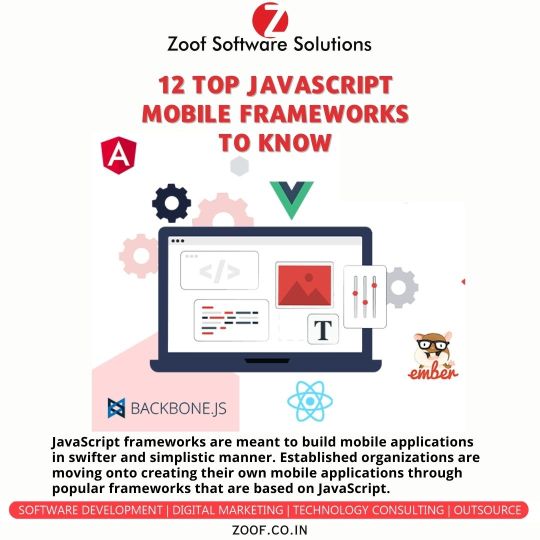
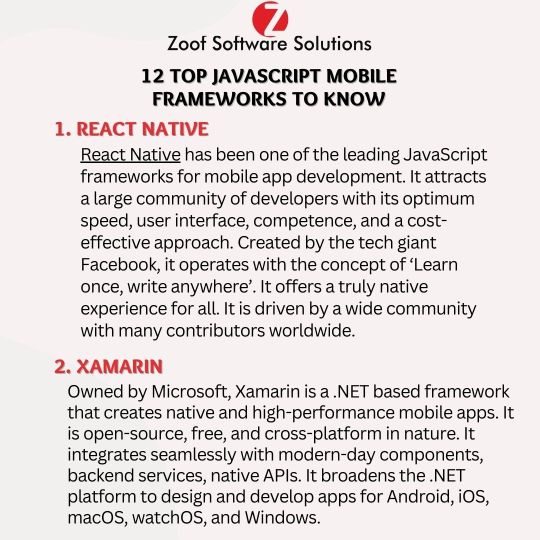
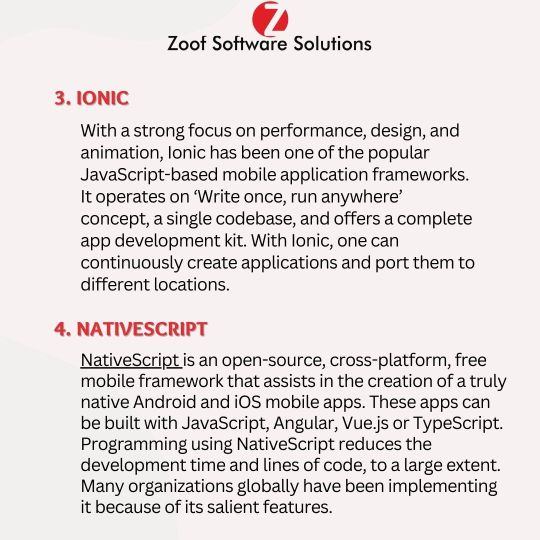
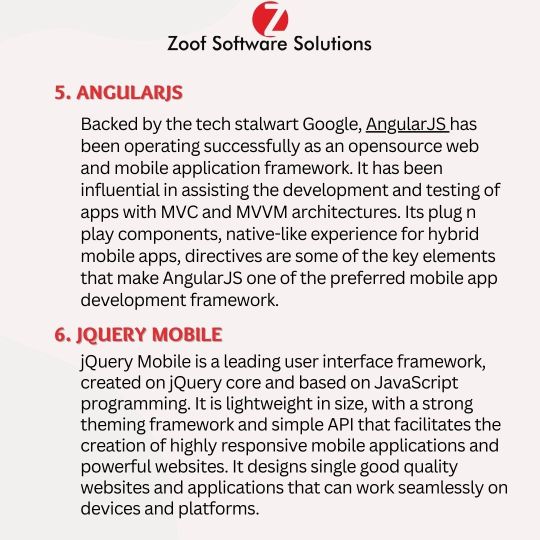
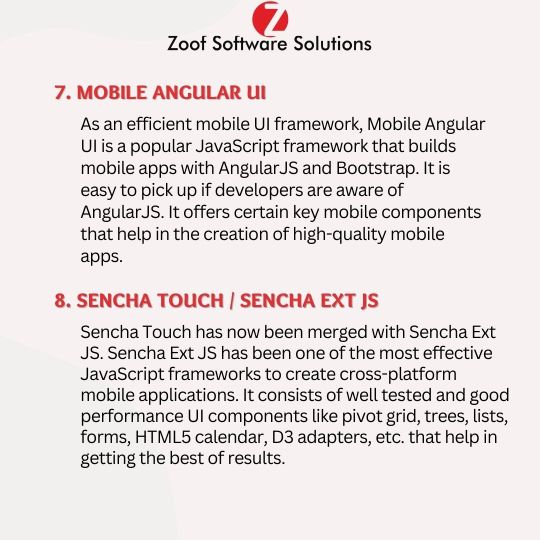
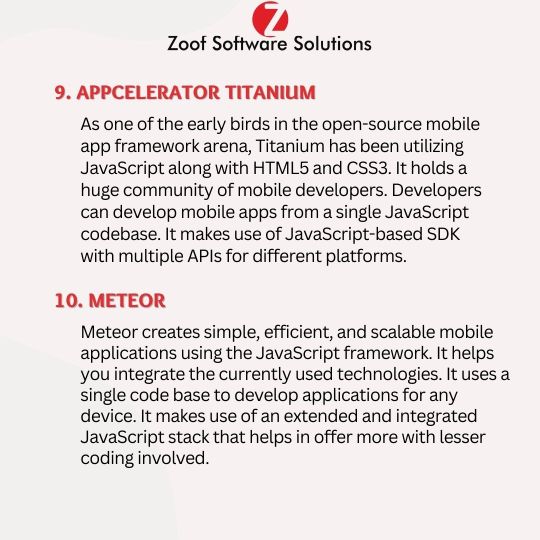
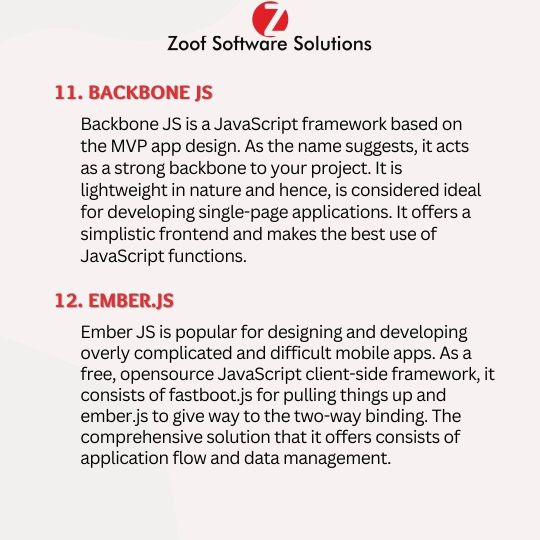
12 Top JavaScript Mobile Frameworks To Know
JavaScript mobile frameworks are tools that allow developers to build mobile applications using JavaScript, HTML, and CSS. These frameworks provide a set of pre-built components and libraries, making it easier to create cross-platform mobile apps that run smoothly on different devices and operating systems.
1. React Native
2. Xamarin
3. Ionic
4. Nativescript
5. AngularJS
6. Jquery Mobile
7. Mobile Angular UI
8. Sencha Touch / Sencha Ext js
9. Appcelerator Titanium
10. Meteor
11. Backbone js
12. Ember.js
#javascript#framework#ReactNative#html#IonicFramework#programming#Flutter#coding#developer#webdeveloper#NativeScript#css#bootstrap#laravel#js#jquery#angular#SoftwareCompany#StartUpTechnology#mobilefriendlywebsite#GrowBusiness#WebsiteDevelopment#SoftwareConsultant#ZoofSoftwareSolutions#zoof#zoofinc#MobileAppDevelopment#AwardWinningCompany#BestSoftwareCompany#digitalmarketing
0 notes
Text
Full Stack Angular Java Developer
What if we told you that developers who work with one programming language or technology may prefer a certain UI framework? Stack Overflow broke developers into groups based on the tag they most visit and examined the percentage of traffic that goes to each of these frameworks.
“The JavaScript ecosystem is richer than ever, and even the most full stack Angular Java experienced developer can start to hesitate when considering the multitude of options available at every stage,” according to The State of JavaScript 2017.
They are not wrong, that’s for sure. A lot of things are happening in the JavaScript world right now and we’re happy to help by showcasing developers’ experiences with different libraries and frameworks. As a matter of fact, the new JAX Magazine issue is all about the JavaScript universe. You can grab your free copy now.
Stack Overflow’s Ian Allen set out to show that “JavaScript UI frameworks and libraries work in cycles.” He used Stack Overflow Trends to see how popular Angular, React, Vue.js, Backbone, Knockout, and Ember are and when their popularity started and/or peaked. He concluded that there seems to be two major phases in JavaScript framework usage:
a quick ascent, as the framework gains popularity
a slightly less quick but steady decline as developers adopt newer technologies
SEE ALSO: “Angular’s refocusing on the enterprise market has left an opening for React to gain ground”
“There are various factors that may go into a developer’s use of one particular front-end framework or another,” Ian wrote in the blog post. “Developers who primarily work with one programming language or technology may be more inclined to choose a certain UI framework.”
He broke developers into groups based on the tag they most visit, and for each group examined the percentage of traffic that goes to each of these frameworks.
Frameworks used along with programming technologies
It seems that developers who primarily work with Java are more inclined to choose Angular, whereas React is more popular with Node.js, and Python developers. Node.js developers are also giving Vue.js some love but not as much as PHP developers.
SEE ALSO: JAX Magazine is out: The darlings of the JavaScript world
Hottest freelance skills: React.js secures Top 5 spot
The number of libraries and frameworks could easily overwhelm anyone so if you’re still on the lookout for the perfect framework and/or library, let’s see what’s trendy these days.
If we look at Upwork’s latest Skills Index, React.js may not be No.1 but it’s important enough (number 5) to be included in the top 5 fastest-growing skills (Q3 2017) in the US. AngularJS development didn’t make the Top 10 freelance skills list but it did occupy a decent position (number 12).
However, this might not be so surprising, if you ask Laurie Voss, co-founder and COO of npm. In a recent interview, he said:
React is growing faster than JavaScript in general, while Angular is basically keeping pace. The difference can probably be explained in terms of “what would a new developer pick?” since that’s where new growth of frameworks tends to come from.
1 note
·
View note
Link

The ReactJS UI Framework list does not end here. There are other more frameworks on the market. It is always vital to select the Appropriate React UI Framework by examining the client's needs and the goal of the React app to be produced, as well as which framework is best for your project.
0 notes
Text
Top 12 ReactJS Libraries and Frameworks in 2022

Building apps for Android and other platforms is standard practice for most app studios. The need for such apps is growing. That's why they're always on the lookout for new Android and cross-platform app development resources including frameworks, libraries, and tools. A similar trend can be seen with the rise in popularity of the Reactjs framework among these types of programmers and their employers. In this article, you will get to know about the top 12 ReactJS Libraries and Frameworks in 2022. Whether you are a reactjs development company or a business looking to hire reactjs developers, this article is for you.
Why is ReactJS considered the best cross-platform app development?
For JavaScript programmers interested in working on a cross-platform or Android app, React is the greatest library available. Additionally, Android app developers utilise JavaScript more than any other programming language. The popularity of the Reactjs framework among Android programmers can be attributed to its compatibility with JavaScript. Moreover, it is easier for reactjs experts or reactjs programmers to provide most of the features that business requires through React js.
What is ReactJS?
Front-end JavaScript programmers utilise the free and open-source toolkit known as React JS or React to create innovative hybrid Android apps that work on several platforms. Its primary function is to aid in the development of superior user interface design for digital products. The user interface, or UI, of a mobile app is crucial to its success. Therefore, the Reactjs framework is utilised to create an excellent user interface for the application, which in turn increases user involvement.
What is React UI Framework?
The React UI framework is an integrated suite of classes and interfaces included in the ReactJS library. It provides a framework for making one's own UI panels, websites, or graphical objects by defining their properties and the behaviour of the already-implemented React UI subsystem. The React UI framework paves the way for the creation of attractive, responsive, cross-platform apps without requiring substantial knowledge, background, or expertise from the developer. List of Best ReactJS Libraries and Frameworks
1. Material UI
If you're using React.js and want a great UI framework that takes use of Google's Material Design, one of the finest options is Material UI, or MUI. It's a one-stop shop for developing and releasing cutting-edge features because of the wealth of UI component libraries and tools it provides. Production-ready components for the MUI React UI framework can be obtained in four distinct products: MUI Core (the framework's baseline), MUI X (more sophisticated components), Templates (pre-made UI layouts), and Design Kits (toolkit for customising MUI components).
ReactJS Development company may use MUI for free with the open-source community edition, or they can pay $15 or $49 per developer per month for the Pro or Premium edition.
2. Redux
Redux welcomes the use of similar frameworks like React. As such, it provides developers and users with a means of managing the system's state. The library works in tandem with Reactjs to facilitate communication between different parts of an app in order to achieve a unified state. In addition, call-backs are not seen as mandatory by the reactjs experts or reactjs experts.
3. Ant Design
Ant Design, developed by Chinese tycoon Alibaba, is a React UI package featuring a variety of ready-to-use components for creating polished user interfaces. On top of that, it features ES6 compatibility and can be easily integrated. Alibaba, Baidu, Tencent, and other market giants now utilise this React library.
4. React Bootstrap
For large, heterogeneous development groups working in parallel on different aspects of an application, React Bootstrap is a great tool. Because the React libraries are already integrated into the Bootstrap core, this is achievable with the React Bootstrap framework.
This React UI framework's unique combination of features allows for granular customization of the appearance and feel of any individual UI element. The Bootstrap framework provides developers with a very accessible framework for building responsive web applications, plugins, and themes.
5. Rebass
Our next stop is Rebass, a React library of rudimentary UI components that may be customised using themes. Built using Emotion, Styled Components, and the Styled System. Despite its Styles System origins, Rebass is compatible with any theme object designed for Styles System. It is also a necessary component library for developing original UI within predetermined design parameters and at a size determined by the user. Because of its small footprint of only 4KB, Rebass is often used for rapid design and development.
6. Grommet
Grommet is an all-encompassing user interface library that can compete with the most advanced React UI libraries. Its primary value is the responsive layouts, designs, elements, and components that are part of its mobile-first UI framework for React. Because it conforms to W3C standards, it is easier to use for people with disabilities. Among the greatest ready-made methods for developing cutting-edge UIs for ReactJS Experts, the Grommet achieves a balance between responsiveness and accessibility.
7. Create React App
You don't need a programming environment to make a mobile app using Create React App. Creating a React App doesn't dictate how you should build apps, but rather actively promotes the use of whichever process works best for you. Effective project kickoffs are within reach with the help of this React component package.
8. React UI
Although it has evolved significantly since its inception, React Bootstrap remains a Bootstrap-based UI library. By switching from Bootstrap's JavaScript to React, you'll have a lot more say over how each component looks and behaves. Every part of the React Bootstrap framework is readily available and crucial to the creation of front-end frameworks. Now, programmers may choose quickly and simply from a variety of premade Bootstrap templates.
9. Ant Design for React
When it comes to creating custom business apps and dashboards, nothing beats the Ant Design of React corporate UI framework. It provides access to premium components that can be used by developers to create visually stunning and functional user interfaces.
Compared to CSS, the code that uses Less.js as its style language is far more compact, well-structured, and straightforward to update and maintain. Commonplace features are included in the basic components, but the addition of more complex elements like comments, cards, timelines, and carousels (to mention a few) makes it suitable for business usage. Due to this, many of the best firms in the react js industry rely on this framework.
10. React Spinner
It's a one-of-a-kind react js package that helps keep visitors on your site. It's connected to the "loading spinner" function seen in many apps that keeps the user engaged while they wait for a web page to load. There are more than 20 app loaders available in the collection. With a high quality user experience, users are more likely to stay with your site.
11. Blue Print
Blueprint is used to create advanced user interfaces for mobile applications. Larger business initiatives have a greater need for a library like this. When building a mobile app, designers may choose to display certain symbols from the component library, set the app's time zone, and work with the local time and date.
12. React Fabric
When it comes to integrating Fluent UI components into React-based projects, the widely-used React Fabric (also known as Office UI Fabric) is the clear frontrunner. Common front-end language modules such as Webpack, CSS (SASS), and ES6+ support React Fabric.
The Fabric framework relies on a set of SASS components and CSS classes to provide you access to countless styles, transitions, and more.
Conclusion
In conclusion, these are the 12 most important libraries and frameworks in 2022 that react js developers can and must use.
0 notes